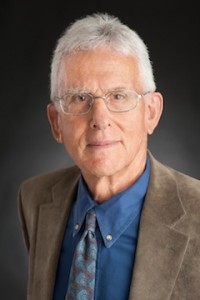Henry Fersko-Weiss, president of the International End of Life Doula Association. (photo from Henry Fersko-Weiss)
Doulas offer support to expectant mothers, guiding women and their partners through the childbirth process and into their first steps of parenthood. Now, a similar concept is gaining ground to fill a need at the end of our lives.
Fear, exhaustion and uncertainty often leave us unsure of how to best support a loved one during their last days, while we also try to deal with our own impending loss.
The idea for end-of-life doulas was conceived by licensed clinical social worker Henry Fersko-Weiss, who works in hospice care in New York and New Jersey.
“There seemed to be a gap in the services that were traditionally available to people,” Fersko-Weiss told the Independent. “As wonderful as hospice is in the U.S., where most people die in their own homes – which is the ideal, unless there’s a cultural reason not to – that’s when people really need help the most.
“They recognize that death is very close and now they can’t avoid thinking about it. They are exhausted and the care demands have increased. They need more help than they were able to access through normal programs. So, I started to think about how to figure this out … and, at the time, a friend of mine was learning how to become a birth doula.”
Fersko-Weiss had not heard about doulas before then. But, as his friend shared with him what she was learning in her training, he increasingly felt this would also be an ideal way to approach the end of life.
“There are a lot of tremendous similarities between birth and death, clear differences as well,” he said. “I became intrigued and started learning more about birth doulas. And, I took the training myself, so I would learn exactly what they were learning.”
By then, Fersko-Weiss was convinced that there were many tools, techniques and principles of care from the birthing world that could be transferred in a very positive way to the end-of-life sphere. So, he went to Carolyn Cassin, the chief executive officer of Continuum Hospice Care in New York City, where he was working at the time, and presented the idea to her. She encouraged him to follow it through.
By 2015, Fersko-Weiss had established a not-for-profit organization that trains and supports end-of-life doulas.
“Currently,” he said, “my work is focused on promoting the use of end-of-life doulas through organizations that care for people at end of life, as well as training people publicly and helping them to achieve certification through the organization that I head: the International End of Life Doula Association.”
To create the program, Fersko-Weiss incorporated some of the concepts from the birth doula training, such as visualization and guided imagery, techniques used by birth doulas to help ease pain.
“I started building on that and writing the training, looking for material that would support some of the things that were important and created a model of the different phases of care that this would offer,” he said. “At that first training, I had 17 people. Once we went through that first training, which was a weekend – which has become the standard for us, about 22 hours – we went on and kept training, and developing the program, and serving patients and their families.”
There are three phases to the model Fersko-Weiss has created, the first of which is summing up and planning. This occurs as early as possible, when the patient and the family are shifting their focus to end-of-life comfort care and away from a cure.
“But, even if they were still focused, to some degree, on a cure, parts of what we do would still make sense, probably even months before somebody would be at the point of dying,” said Fersko-Weiss. “We work on exploring the meaning of their life, as they look back over their life, and help them think about what they might want to leave behind as a legacy that reflects that meaning that they’ve uncovered or what they think is important for their loved ones and friends to remember them by or to carry into their lives.”
Psychologist Erik Erikson has examined the different developmental stages that we go through within our lifespan and refers to the last of these stages as “integrity versus despair.”
“When somebody is dying and facing death, they are automatically propelled into that final developmental stage, no matter what age,” said Fersko-Weiss. “In that stage, they have to contend with coming to the point of a positive completion of their life as they go through reviewing their life. Or else, they move towards despair, anguish and feeling that their life either didn’t matter or didn’t fulfil their dreams.”
The other aspect of the first phase of Fersko-Weiss’ program is planning what one’s last days of life will look like. This entails finding out what would be most helpful to them and their family to allow those last days to unfold in a way that honors who they are, carries deeper meaning for everyone involved and makes it easier for the person to approach death.
The second phase of the program is when the person is actively dying, which generally comprises the last two to four days of life.
“We stay with people as much as possible, around the clock,” said Fersko-Weiss. “We help them understand what is coming next. We support the family emotionally and spiritually, and we assist with physical care in a basic way.
“We will stay [with the family] through the death,” he continued. “We will wait hours afterwards to give them time to process it and have the death experience sink in a bit. We sometimes call the funeral home for them, or friends, if they are too emotional. We stay with them through the body being removed from the home and also up to the point where they feel more comfortable being on their own.”
Phase three of the program has the doula returning to the family three to six weeks following the death to review and tell the story of the dying process. This helps the family see some of the many beautiful and loving things they did together during that time, reminding them how things went, as they may have not have been thinking clearly during that time due to the pain of loss.
“This is done as a way to reframe some of the negative pieces that they are carrying that may be coming back to them over and over again in their mind, and help them to begin the very early stage of grief, understand what grief work is about,” said Fersko-Weiss. “We help them through some of the early grief work and then refer them to programs in the community or within the organization that were perhaps involved with the care as well. We may, at that point, do a final ritual to bring closure to our work with them.”
The end-of-life doula service is provided primarily by hospice and out-care programs, which may be part of a hospital. Fersko-Weiss is working to spur interest in this service at assisted living facilities and nursing homes. This type of care is also starting to be done by groups of people getting together to provide the service to a dying person and their family.
Fersko-Weiss has been teaching at the Institute of Traditional Medicine in Toronto, doing a compressed form of the doula training he offers in the United States. Students attend classes one weekend a month for six months, and graduate as certified contemplative end-of-life-care practitioners.
“My understanding of hospice in Canada is that many people are very underserved,” he said. “There are a lot of people who are dying without the ability to access hospice care in Canada.”
Fersko-Weiss has also been working with a Canadian organization called the Home Hospice Association.
“They are still in the process of forming, but their intention is to provide home hospice in Canada and to solve the problem of lack of access,” he said. “Their intention is to build into that program the utilization of end-of-life doulas.”
Rebeca Kuropatwa is a Winnipeg freelance writer.



